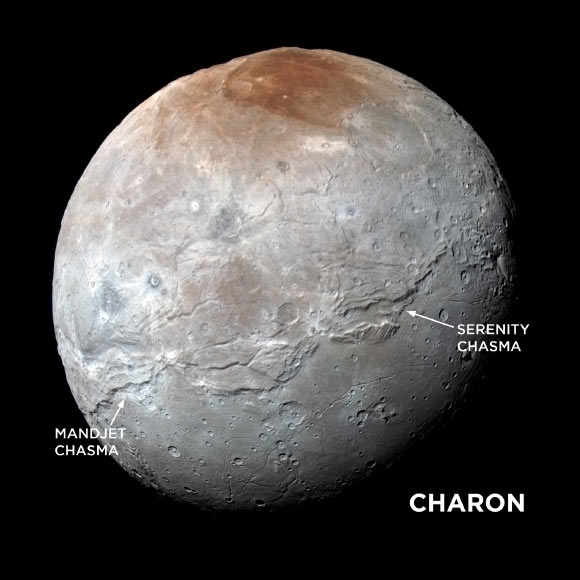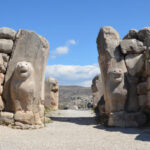When ocean-bearing moons begin to cool down, their oceans can freeze. As new ice accretes to the bottom of the existing ice shell, the added volume of the ice can stress the shell. Pluto’s largest moon, Charon, has canyons and cryovolcanic flows that may have formed in response to a freezing ocean. In new research, planetary scientists from the Southwest Research Institute, the University of California, Davis, and the University of California, Berkeley modeled the formation of fractures within Charon’s ice shell as the ocean underneath it freezes to explore the evolution of the moon’s interior and surface. They found that an ocean source for cryovolcanic flows is unlikely because the ice shell would have had to be much thinner than current thermal evolution models imply; however, freezing the ocean may have produced the stresses that formed canyons later in Charon’s history.
Rhoden et al. revisited New Horizons data to explore the source of cryovolcanic flows and an obvious belt of fractures on Charon. Image credit: NASA / Johns Hopkins University Applied Physics Laboratory / Southwest Research Institute.
“A combination of geological interpretations and thermal-orbital evolution models implies that Charon had a subsurface liquid ocean that eventually froze,” said Dr. Alyssa Rhoden, a researcher at the Southwest Research Institute.
“When an internal ocean freezes, it expands, creating large stresses in its icy shell and pressurizing the water below.”
“We suspected this was the source of Charon’s large canyons and cryovolcanic flows.”
New ice forming on the inner layer of the existing ice shell can also stress the surface structure.
To better understand the evolution of the moon’s interior and surface, Dr. Rhoden and colleagues modeled how fractures formed in Charon’s ice shell as the ocean beneath it froze.
They modeled oceans of water, ammonia or a mixture of the two based on questions about the makeup.
Ammonia can act as antifreeze and prolong the life of the ocean; however, results did not differ substantially.
When fractures penetrate the entire ice shell and tap the subsurface ocean, the liquid, pressurized by the increase in volume of the newly frozen ice, can be pushed through the fractures to erupt onto the surface.
Models sought to identify the conditions that could create fractures that fully penetrate Charon’s icy shell, linking its surface and subsurface water to allow ocean-sourced cryovolcanism.
However, based on current models of Charon’s interior evolution, ice shells were far too thick to be fully cracked by the stresses associated with ocean freezing.
The timing of the ocean freeze is also important. The synchronous and circular orbits of Pluto and Charon stabilized relatively early, so tidal heating only occurred during the first million years.
“Either Charon’s ice shell was less than 10 km (6 miles) thick when the flows occurred, as opposed to the more than 100 km (60 miles) indicated, or the surface was not in direct communication with the ocean as part of the eruptive process,” Dr. Rhoden said.
“If Charon’s ice shell had been thin enough to be fully cracked, it would imply substantially more ocean freezing than is indicated by the canyons identified on Charon’s encounter hemisphere.”
Fractures in the ice shell may be the initiation points of these canyons along the global tectonic belt of ridges that traverse the face of Charon, separating the northern and southern geological regions of the moon.
If additional large extensional features were identified on the hemisphere not imaged by NASA’s New Horizons spacecraft, or compositional analysis could prove that Charon’s cryovolcanism originated from the ocean, it would support the idea that its ocean was substantially thicker than expected.
“Ocean freezing also predicts a sequence of geologic activity, in which ocean-sourced cryovolcanism ceases before strain-created tectonism,” Dr. Rhoden said.
“A more detailed analysis of Charon’s geologic record could help determine whether such a scenario is viable.”
The study was published in the journal Icarus.
_____
Alyssa Rose Rhoden et al. 2023. The challenges of driving Charon’s cryovolcanism from a freezing ocean. Icarus 392: 115391; doi: 10.1016/j.icarus.2022.115391




